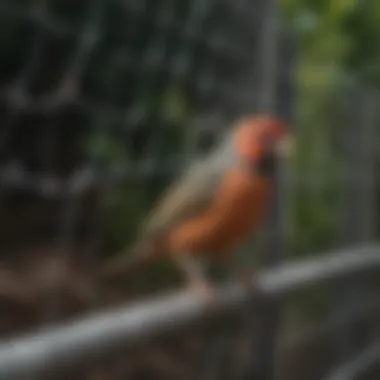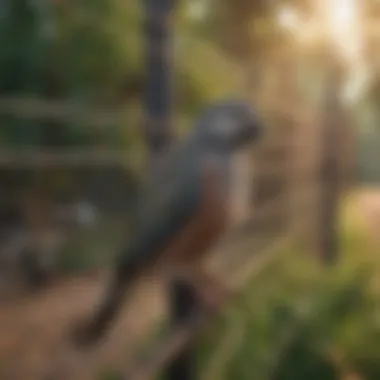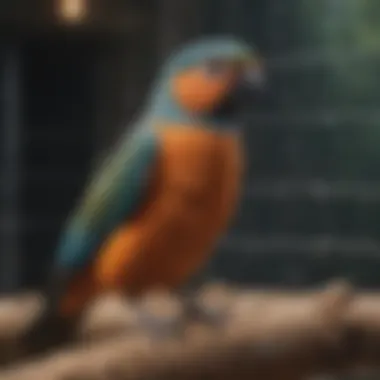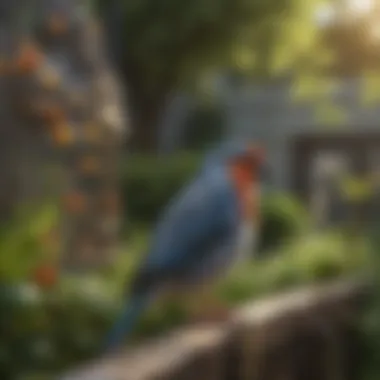Aviary Wire Fencing: Insights for Caring Pet Owners


Intro
Aviary wire fencing plays a critical role in ensuring the safety and health of birds in pet owners' care. With various types available, knowing which kind suits your needs is essential for effective pet care. This article covers key insights into aviary wire fencing, focusing on its significance, types, how to install it properly, and maintenance practices.
Understanding your pet's requirements and behavior is indispensable when planning an aviary. Birds have unique needs that vary significantly among species. Knowing this allows for better selection of the right aviary wire fencing. Proper installation not only secures your pets but also promotes a safe environment for them to thrive.
Maintenance is equally important. Regular checks and upkeep of your aviary will extend its life and ensure the safety of your birds. This article provides a comprehensive guide tailored for pet owners, highlighting essential information that empowers informed decisions regarding aviary wire fencing.
Understanding Your Pet
Pet Behavior Basics
Birds exhibit distinct behavior patterns that are essential to understand. They are social creatures, often enjoying interaction with their environment and each other. Knowing their social dynamics is important for choosing the right kind of fencing. Different breeds and species have varied preferences for space and social contact.
Common Breed Characteristics
Not all birds are alike; each breed comes with unique characteristics. For instance, parrots are highly intelligent and require stimulating environments. In contrast, canaries are quieter and prefer less interaction but still need suitable living arrangements. Familiarizing yourself with these traits helps ensure your aviary fencing meets those specific needs.
Species-Specific Needs
It is crucial to consider specific needs based on your birds' species. Parrots, for example, may require wider spacing in the wire to facilitate climbing, while finches might need a denser mesh to ensure safety. Tailoring your aviary wire fencing to these requirements enhances birds' well-being and reduces stress.
Importance of Aviary Wire Fencing
Aviary wire fencing is not merely for confinement; it serves multiple essential purposes. It protects birds from potential predators, ensures enclosure integrity, and provides a safe environment for their activities.
Understanding Aviary Wire Fencing
Aviary wire fencing serves as a foundational element for the security and well-being of birds in a home or professional setting. It is important to comprehend what aviary wire fencing is, as well as the various needs it fulfills for avian pet owners. Understanding these elements can ensure proper protection against potential threats, while also maintaining an environment that is conducive to the health of the birds within.
Definition and Purpose
Aviary wire fencing refers to a durable mesh structure designed to create a safe enclosure for birds. It serves as a boundary, allowing birds to experience the outdoor environment while protecting them from predators and unwanted intrusions. Such fencing can be made from several materials, each with its own set of benefits and drawbacks.
The primary purpose of aviary wire fencing is to keep birds confined within a safe area, preventing them from escaping and minimizing the risk of encounters with natural threats such as cats or raccoons. It also allows owners to enjoy the beauty and songs of their avian companions without constant worry. Additionally, using adequate fencing minimizes human interference, which is vital for maintaining a stress-free environment for the birds.
Importance in Bird Keeping
The significance of proper aviary wire fencing cannot be overstated for individuals who keep birds. Effective fencing supports both the physical and psychological welfare of the pets. Birds are sensitive creatures, and the right enclosure enables them to feel secure. It allows for movement and natural behaviors while offering boundaries that protect them from external dangers.
Furthermore, the type of fencing used can influence the overall habitat quality. For instance, quality materials resist corrosion and damage caused by weather. This not only prolongs the life of the structure but also enhances safety.
Choosing the right aviary wire fencing is therefore an essential component of bird keeping, directly impacting the quality of life for these animals. Investing in proper fencing can also help reduce stress for the owner, knowing that their pets are secure.
Proper aviary wire fencing offers a balance between accessibility to the outdoors and safety from threats, making it a critical element in caring for avian pets.
In sum, understanding aviary wire fencing is crucial for ensuring the well-being of birds. It significantly contributes to a safe, engaging, and pleasant environment for both the birds and their owners.
Types of Aviary Wire Fencing
Understanding the types of aviary wire fencing is crucial for any pet owner focused on bird care. The material you choose has significant implications for both the safety of your birds and the longevity of the structure. Each type of fencing comes with its benefits and considerations, which will be explored in the following sections. A nuanced understanding of these options allows owners to make informed decisions that protect their avian companions.
Metal Wire Fencing
Galvanized Steel


Galvanized steel is a popular choice among aviary owners due to its robustness. The specific aspect that sets it apart is the protective zinc coating, which helps prevent rust and corrosion. This makes galvanized steel especially useful in outdoor aviaries subjected to varying weather conditions. Its durability means that it can withstand significant wear and tear compared to other materials, contributing to long-term savings.
One unique feature of galvanized steel is its ability to provide a safe environment for birds. The sturdy construction minimizes the risk of escape or predation. However, it may come with a downside related to weight. Installing such fencing can require additional effort and resources.
Stainless Steel
Stainless steel is synonymous with resilience. It offers a high level of corrosion resistance, making it suitable for environments with moisture. The key characteristic of stainless steel is its sleek appearance combined with the ability to withstand harsh elements over time. This makes it an appealing option for those who prioritize aesthetics along with functionality.
Another unique advantage of stainless steel is its relatively low maintenance needs. Owners do not need to worry about frequent repairs or replacement, reducing long-term costs. However, the downside is its higher initial cost, which might deter some budget-conscious pet owners.
Plastic Coated Wire
Benefits of Coating
Plastic coated wire is another option that appeals to many aviary owners. The main benefit of coating is that it enhances the durability of the wire while providing an extra layer of protection against the elements. This feature helps prevent rust and degradation, extending the life of the fencing. Additionally, the coating can provide a more comfortable touch for birds, reducing the risk of injury.
Many opt for plastic-coated wire for its versatility and ease of handling. It is lighter than metal alternatives, making installation easier. Yet, it is important to note that it may not be as sturdy, leading to potential safety concerns.
Drawbacks
On the other side, plastic coated wire does come with drawbacks. The coating may wear off over time, exposing the underlying metal. This can lead to rust if not monitored regularly. While the initial investment may be lower, long-term maintenance can become an issue, leading some pet owners to reconsider their choices.
Wood and Other Natural Materials
Usage in Aviaries
Using wood or other natural materials in aviaries offers distinct advantages. Natural aesthetics appeal to many bird owners who prefer a more organic look. The specific aspect of wood is its ability to blend seamlessly into garden environments, enhancing visual appeal. Additionally, it can provide a warmer environment for birds, which may contribute positively to their overall wellbeing.
However, the usage of wood also raises specific considerations. Wood is susceptible to rot and insect infestation, so proper treatment and regular maintenance are essential to ensure safety and durability.
Pros and Cons
Each material comes with its pros and cons.
- Pros:
- Cons:
- Aesthetically pleasing
- Insulation properties for birds
- Vulnerable to weather conditions
- Maintenance-heavy to prevent deterioration
In general, while wood is an attractive option, its practicality may vary widely based on environmental factors and personal commitment to upkeep. Each material type serves its purpose and comes with varying benefits, helping pet owners tailor their aviaries to suit both their needs and those of their feathered friends.
Choosing the Right Wire Fencing
Choosing the right wire fencing is crucial for ensuring the safety and well-being of your birds. This section addresses important elements to consider when selecting fencing for your aviary, covering specific factors and safety features that directly affect the effectiveness of your setup.
Factors to Consider
Size of Aviary
The size of your aviary is one of the most important aspects to consider. A larger aviary requires stronger and possibly thicker wire to prevent bending or deformation. Moreover, it affects the spacing of the wire mesh, which needs to be close enough to prevent birds from escaping while allowing for adequate airflow and light. A properly sized aviary enhances the comfort of your birds and allows them to exhibit their natural behaviors, making it a popular choice among pet owners. However, be mindful that larger aviaries may require more investment in terms of materials and installation.
Bird Species
Different bird species have specific needs and behaviors that influence the type of wire fencing that is suitable. For instance, larger birds like parrots may need more robust fencing to withstand their strength. Smaller finches or canaries might require finer mesh to ensure they cannot escape. Understanding the key characteristics of your bird species ensures the selection of an effective fence that supports their safety and well-being. Choosing wire fencing based on your bird species’ unique features helps to prevent accidents and escapes, creating a secure environment for your feathered friends.


Safety Features
The safety features of your fencing choice can't be overstated. Prioritize options that minimize the risk of injury to your birds. This may include smooth wire edges to prevent cuts, as well as a tight mesh design that secures small gaps. Selecting wire fencing with a protective coating can also enhance durability and resistance to elements. An effective wire fencing system should balance protection with the comfort of your birds, ensuring they can thrive in their environment. Regular assessment of these safety features can significantly contribute to the longevity of your aviary fencing.
Installation Process
The installation process of aviary wire fencing is a crucial step that can significantly affect the longevity and efficiency of an aviary. Proper installation ensures that the birds are secure from both internal and external threats. Moreover, understanding the installation process allows pet owners to create an environment that promotes the well-being of their birds while also adhering to regulations. This section provides valuable insights into planning and executing a successful installation, ensuring that the aviary serves its intended purpose effectively.
Pre-Installation Planning
Site Assessment
Site assessment is the first step in the installation planning. This involves evaluating the physical location where the aviary will be placed. Key factors include the terrain, available space, and existing vegetation. A proper site assessment can help in determining the suitability of the area for constructing an aviary.
One key characteristic of site assessment is its adaptability. Different sites might present unique challenges and advantages. For example, a location with natural shade can help moderate temperature inside the aviary, while open areas may better suit larger structures. This adaptability makes site assessment a popular choice in aviary planning.
A unique feature of site assessment is its proactive approach to avoiding future problems. By identifying potential hazards such as flooding or excessive wind, owners can take steps to mitigate these risks. Hence, proper analysis can lead to a more effective aviary design and can save considerable time and resources in the long run.
Permits and Regulations
Permits and regulations are essential elements that can influence the installation process. Complying with local regulations ensures that the construction is legal and safe. It involves understanding zoning laws and building codes in the area where the aviary is to be built. The key characteristic of permits and regulations is their emphasis on safety and compliance. This reduces the risk of fines or logistical issues.
Furthermore, navigating these requirements can lead to a smoother installation process. The unique feature of understanding permits is the clarity it provides. Knowing what is required can help in planning the project effectively without any surprises. However, it can also be a bit challenging, especially for those unfamiliar with legal jargon. Owners must allocate time for this phase, ensuring compliance before moving into installation.
Step-by-Step Installation Guide
Following a clear step-by-step guide can simplify the installation process and help owners avoid common pitfalls. Here are some critical steps to consider during installation:
- Gather Materials: Make a list of all necessary tools and materials needed for installation. This includes aviary wire, support posts, and fasteners.
- Lay Out the Design: Mark the area where the aviary will be located and visualize the structure to be built. Ensure the design is suitable for the bird species being housed.
- Prepare the Ground: Clear the area of debris and level the ground for a stable base. If using posts, holes should be dug to appropriate depths to ensure stability.
- Install the Framework: Begin by installing the support posts according to your plan. Make sure they are securely anchored.
- Attach the Wire Fencing: Carefully attach the wire fencing to the framework and ensure it is taut to prevent sagging.
- Check for Gaps: Inspect for any gaps or areas where birds could escape or predators could enter. Addressing these areas during installation is critical.
- Finalize the Structure: Once the wire is in place, consider adding features such as doors or windows for human access, keeping convenience in mind.
Each of these steps contributes to creating a secure and functional aviary that will stand the test of time. By understanding the importance of proper installation, pet owners will be better prepared for maintaining a safe habitat for their birds.
Maintenance Practices
Maintaining aviary wire fencing is critical for several reasons. Proper maintenance ensures the safety and health of the birds, prolongs the lifespan of the fencing itself, and helps prevent costly repairs in the future. Neglecting maintenance can lead to various issues that may compromise the structure's integrity and the well-being of the birds within. By regularly checking and addressing any wear and tear, pet owners can create a secure environment for their avian companions.
Regular Inspections
Identifying Wear and Tear
Identifying wear and tear is an essential part of maintaining aviary wire fencing. Regular inspections allow pet owners to spot any damage or deterioration before it worsens. Signs of wear can include rust on metal fences, frayed edges on wire, or scratches and other physical damage. This aspect is crucial because it directly contributes to the overall safety of the aviary. The key characteristic of identifying wear and tear is its proactive approach, allowing for timely interventions. This is a beneficial choice for pet owners because it minimizes the risk of fencing failure.
Moreover, wear and tear can often be a symptom of larger environmental issues or stressors affecting the aviary. For instance, if corrosion is frequent, it could suggest improper material selection for the location's climate. Ensuring regular checks enhances the longevity of the fencing and provides assurance that the birds are safe.
Addressing Common Issues
Addressing common issues related to aviary wire fencing is a fundamental maintenance practice. Common problems include bent or broken wires, loose connections, and signs of rot in wooden structures. By promptly dealing with these issues, pet owners contribute to the structural integrity of the aviary. This aspect is particularly important as it helps maintain the primary goal of the fencing, which is to secure the birds.
The key characteristic of addressing common issues lies in its systemic approach. It is a beneficial choice because it lays out clear actions to enhance the fencing's condition. Unique features of this practice include regular maintenance logs and scheduled inspections, which help pet owners stay ahead of potential problems. The advantages here include increased durability of the fencing and a safer habitat for the birds.
Cleaning and Upkeep
Cleaning and upkeep are vital for the overall maintenance of aviary wire fencing. Regular cleaning prevents the buildup of debris, mold, or mildew, which can negatively impact the structure and the health of the birds. It is advisable to use gentle cleaning agents that do not pose a risk to the birds while ensuring effective removal of contaminants. By prioritizing cleaning, pet owners can ensure that their aviaries remain a safe and inviting home for their birds.
Challenges in Using Aviary Wire Fencing


Using aviary wire fencing can present various challenges for pet owners. Understanding these challenges helps to prepare for and mitigate potential issues. The most significant challenges include environmental factors and predator threats. These elements can affect not only the durability of the fencing but also the safety of the birds housed within the aviary.
Environmental Factors
Corrosion and Weather Resistance
Corrosion significantly affects aviary wire fencing, especially if it is exposed to harsh weather conditions. Metal wire can deteriorate over time due to rust, especially in humid or rainy environments. Therefore, selecting materials that resist corrosion is crucial. Galvanized steel and stainless steel are popular choices because they have coatings or properties that reduce rust formation. This durability ensures that the fencing remains intact longer, providing better security for the birds.
A unique feature of corrosion-resistant materials is their ability to maintain structural integrity against environmental stressors. Choosing fencing that withstands such conditions ultimately prolongs its lifespan, reducing the need for frequent replacements.
UV Damage
UV damage poses another risk to aviary wire fencing, particularly for those using plastic-coated wires. Prolonged exposure to sunlight can cause the plastic coating to become brittle and break down. This degradation can lead to safety hazards for the birds. A key characteristic of UV-resistant materials is their formulation to withstand sun exposure without significant wear.
The main advantage of using UV-resistant materials is the longer lifespan for the fencing. However, such materials may come at a higher initial cost. Balancing cost with long-term benefits is crucial for pet owners contemplating fencing options in sun-rich environments.
Predator Threats
Predators, including birds of prey and even domestic animals, can pose serious risks to birds in aviaries. Solid fencing is essential to prevent attacks. Wire fence must be strong enough to deter predators, and a careful inspection of the design is necessary. This action includes checking for gaps that potential intruders may exploit.
Security features, such as buried wire or angled tops, can further enhance protection against predators. Understanding these threats allows pet owners to choose the correct fencing systems that align with their specific needs for safety and security. An informed decision ensures that birds remain secure within their aviaries.
Alternative Solutions
As responsible pet owners, exploring alternative solutions to traditional aviary wire fencing is crucial. These options may provide enhanced safety, versatility, or cost-effectiveness. Understanding these alternatives can lead to better decisions, safeguarding your birds while accommodating varied environmental factors. In this section, we will analyze two primary alternatives: netting options and fencing combinations.
Netting Options
Netting serves as a valuable alternative to wire fencing, especially for larger aviaries. It offers several advantages, making it a popular choice among bird enthusiasts. Here are some key benefits to consider:
- Flexibility: Netting can adapt to various shapes and sizes of aviaries, providing ease in installation.
- Visibility: Unlike thick, solid walls, netting ensures visibility for birds and owners, creating an open environment.
- Light and Air Flow: The material allows natural light and air circulation, promoting a comfortable habitat for your birds.
Despite these benefits, some considerations are important when choosing netting. Ensure the material is durable and UV-resistant to prevent degradation from sun exposure. Additionally, select a mesh size small enough to keep out potential predators, such as hawks or raccoons, while still permitting the passage of light and airflow.
Quote: "Choosing the right netting can significantly impact the safety and well-being of your avian friends."
Fencing Combinations
Using a combination of fencing materials can be an effective strategy for securing your aviary. This approach allows pet owners to enhance their structures' safety and aesthetics. Here are some popular combinations to consider:
- Wire Fencing with Netting: The use of a robust wire fence as a base layer, combined with netting above, can deter aerial predators while maintaining visibility and airflow.
- Wooden Frames with Wire Grills: A wooden frame provides an attractive look, while wire grills serve as protection against burrowing animals.
Before implementing any fencing combination, evaluate specific environmental factors. Consider local wildlife threats, the climate, and the habitat needs of the birds. Tailor the combination to create a balance between protection and the birds' natural living conditions.
In summary, alternative solutions like netting options and fencing combinations present exciting possibilities for aviary safety. Thoroughly assessing each option will help pet owners make informed decisions to create secure and inviting spaces for their birds.
Finale
Understanding the Importance of Proper Fencing
The role of aviary wire fencing cannot be overstated when it comes to creating a safe haven for birds. Proper fencing is vital to secure aviaries from external threats and prevent the escape of birds. It provides a barrier against potential dangers such as larger predators and harsh weather. Additionally, appropriate fencing helps maintain a controlled environment, essential for the health and well-being of captive birds. It ensures that they feel secure and can thrive in their habitats.
The choice of materials is also a crucial aspect. Different types of wire have distinct properties. For example, galvanized steel is often preferred for its durability and resistance to corrosion. Meanwhile, stainless steel offers strength without compromising aesthetic appeal. By selecting the right materials and designs, pet owners can ensure a long-lasting solution that supports the needs of avian residents.
By fostering an understanding of these principles, pet owners become more informed and engaged in the well-being of their birds. This leads to better decision-making regarding fencing options, ultimately enhancing the experience of keeping birds.
Future Trends in Aviary Fencing
As technology progresses, the landscape of aviary wire fencing is evolving. One noticeable trend is the integration of smart technologies. Fences equipped with sensors can alert owners about unauthorized entries or breaches, significantly improving security. Moreover, innovations in materials are focusing on durability and sustainability. Biodegradable options are becoming available, which help reduce the environmental impact without compromising functionality.
Another trend involves customizable designs. Tailored fencing solutions can suit specific environments and meet particular needs. For instance, companies are exploring modular fencing systems that allow easy adjustments based on changing conditions or requirements. This flexibility can be especially valuable for pet owners who may relocate or expand their aviaries in the future.
In summary, aviary wire fencing continues to adapt alongside advancements in technology and materials science. Staying abreast of these trends can equip pet owners with the tools they need to create safer and more effective enclosures for their cherished birds.







